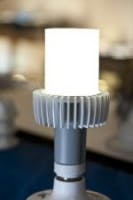Cree develops prototype LED lamp that delivers 152 lm/W
Cree has announced an LED-retrofit A-lamp that meets stringent performance goals, although the company has no immediate plans to market the product. The company has developed a prototype that delivers 1330 lm and consumes 8.7W, with an efficacy of 152 lm/W.
Cree says that the prototype “exceeds the performance goals” of the US Department of Energy (DOE) L Prize Competition in the 21st Century Lamp category. The DOE has yet to fully define the requirements of this third element of the L Prize competition, although it has said that 150 lm/W efficacy would be a requirement.
Non-traditional looks
The new lamp looks significantly different than most LED retrofit lamps and decidedly different from a traditional incandescent bulb. In a video, below, Gerry Negley, Cree's CTO and co-inventor of the bulb, said, “I don’t know what lighting will look like in the 21st century. I can tell you it will not be constrained with shapes and technology of the past. It will not look like a traditional light bulb.”
Indeed we have already seen a number of SSL lamps that depart from traditional looks. But Cree is taking liberties in suggesting that the prototype might meet the undefined 21st Century L Prize requirements (except in terms of efficacy), and the unusual shape of the lamp could be an issue.
The prototype appears to be cylindrical in terms of the lighting globe or diffuser, as shown in the photo. And a cylindrical heat sink, which is larger than the optical element, forms the base of the lamp. Such a design would not provide an omnidirectional distribution of light. No one knows for sure what requirements the DOE will define for the third L Prize category. But we do know that in the 60W category, an omnidirectional distribution is a requisite.
Cree won’t reveal any of the design details used in the prototype other than saying it uses Cree TrueWhite technology. TrueWhite is Cree’s approach to mixing red LEDs with phosphor-converted yellow LEDs to deliver warmer color temperatures with greater efficacy than is possible using white LEDs alone.
Third-party validation
Cree says that the prototype has a CCT of 2800K and a CRI of 91. Cree had the performance and color specifications verified by third-party testing lab OnSpeX.
A retrofit lamp in the 150 lm/W range could certainly have a big impact on energy usage. Cree co-founder Neal Hunter said, “We calculate that if fully deployed, LED lighting at 150 lm/W could bring a 16.5% reduction in US electrical-energy consumption, returning it to 1987 levels.” But Cree isn’t saying when such a lamp might be manufactured.
Back in January, Cree announced a prototype of a 60W-replacement lamp that it said was the first design that could meet Energy Star requirements. Since then Philips has achieved Energy Star compliance with its EnduraLED 60W-replacement lamp.
Cree has consistently said that its lighting systems business is primarily focused on helping customers of its LED components business solve design problems. Essentially Cree creates systems from which LED customers can borrow design elements. Cree does sell LED luminaires such as downlights and linear-fluorescent-replacement fixtures. To date the company has not sold LED retrofit lamps.






